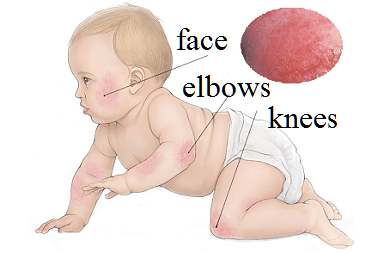Dermatology >>>> If diagnosed with atopic dermatitis
If diagnosed with atopic dermatitis.

Signs of atopic dermatitis.
Clinical manifestations or signs of atopic dermatitis are associated with different age periods. It is customary to distinguish three age periods and associate with each of them the degree of prevalence of the inflammatory process, its localization and the level of severity of the disease.
Period from birth to 2 years:
It is characterized by an exudative form of atopic dermatitis (hyperemic skin (reddened), swelling, oozing crusts) and an acute (or subacute) nature of the disease. The foci of atopic dermatitis are located on the face, in the area of flexion and extensor surfaces of the limbs, on the outer surface of the legs. By the end of this age period, the foci of inflammation are localized in the areas of the neck, wrists, elbows, popliteal fossa.
Period from 2 to 12 years:
During this period, the inflammatory process takes on a chronic nature: the skin peels off, thickens, erythema and papules form, lichenization develops (the skin pattern increases), cracks and scratches appear. In places where inflammation decreases or disappears, hyper- or hypopigmentation may occur, sometimes additional folds of the lower eyelid are formed. The foci of the disease are located on the elbow and popliteal folds, flexor-extensor parts of the limbs, on the back of the neck, behind the auricles.
Period from 13 years old and adults:
In this period, infiltration processes, lichenization prevail, erythema has a color from red to bluish tint, papules merge, rashes are characterized by selectivity of the localization site - the upper half of the body (face, neck, upper limbs).

All age periods are characterized by:
Itching of varying intensity
- Different degrees of prevalence (limited localization of inflamed foci; lesion area up to 10% of the skin; lesion area - from 10 to 50% (common atopic dermatitis); foci occupy more than 50% of the skin (this is a diffuse form of atopic dermatitis))
- Varying severity from 1-2 rashes per year, several exacerbations per year to a continuous recurrent course of the disease
Treatment of atopic dermatitis.
In the treatment of atopic dermatitis, several measures are followed:
1) Identification of factors causing exacerbation (allergic, infectious, irritants, environmental factors, stress)
2) Therapeutic treatment, structured in several directions:
Protecting the skin from negative environmental influences:
- Soft cotton clothing (pre-washed to reduce the amount of residual chemical compounds in the fabric)
- Clothes and bedding are washed with PH-neutral detergents and rinsed thoroughly
- Cover the foci of the disease with clothes
- Humidify indoor air
- Limit activities that lead to increased sweating
- Shower and bathroom should have a comfortable water temperature (not hot)
- It is advisable to dechlorinate bathing water
- Use hypoallergenic soaps, foams, gels and shampoos
- Do not use synthetic washcloths and other products that injure the skin (the washcloth should be made of terry cloth)
- Do not use body scrubs
- Do not use alcohol-based products
- Moisturizing skin prevents dryness , cracking and excessive keratinization
- Softening the skin with hypoallergenic creams, ointments
- Dosed ultraviolet irradiation of foci of atopic dermatitis (except for sunburn, which can cause skin burns, which means additional injury)
Use of glucocorticosteroids
- local glucocorticosteroids
- systemic glucocorticosteroids (only in severe cases)
The use of membrane stabilizers (they simultaneously act as blockers of histamine H1 receptors and inhibit the release of mediators of allergic inflammation from mast cells)
- Cromoglicic acid preparations (nalcrom)
- Ketotifen
Anti-infective therapy
- Antibiotics corresponding to the identified bacterial strains
- Antifungal drugs
- Antiviral medications (for example, antiherpetic drugs)
Antipruritic therapy
- Systemic blockers of H1-histamine receptors (with hyperemia, edema, itching) of the first and / or second generation, depending on the severity of the course of the disease in various doses and combinations
- Tricyclic antidepressants
- Anxiolytics
- Local anesthetics
-
- Recombinant interferons-gamma (inhibit IgE synthesis and inhibit Th2 lymphocyte activity)
- The use of topical calcineurin inhibitors (activation of calcineurin initiates the transcription of cytokine genes ) - available as ointments and make it possible to use them locally
Means that improve the functions of the digestive system
- Prebiotics
- Probiotics
- Preparations that promote fast food evacuation
- Compliance with the diet in atopic dermatitis
Treatment for atopic dermatitis should always be comprehensive. The doctor needs the skills to combine drugs and procedures, depending on the patient's age group, the severity of the disease, the extent of the inflammatory foci. The goal of the treatment of atopic dermatitis is to reduce the number of relapses, achieve stable remission, and, if the situation is successful, its disappearance (quite often the disease recedes after passing the turn of 14-15 years of age).

Read

Read


























